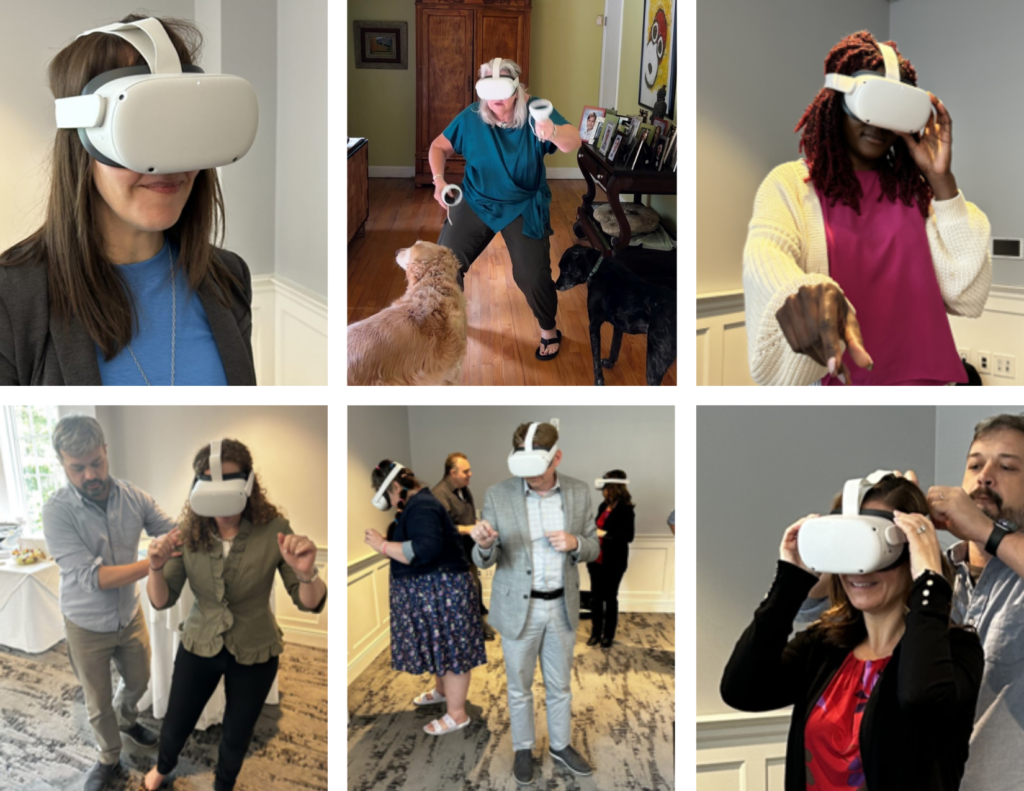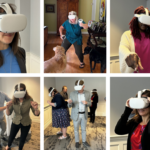Achieving resonance & ROI with immersive storytelling
By Trish Nicolas in collaboration with Kelly Bench,
project support by RF Studio 53’s video production team
August 22, 2023

Trish Nicolas (in collaboration with Kelly Bench; project support by RF Studio 53’s video production team)
These days, almost anyone can put on a virtual reality (VR) headset and be immersed in any virtual world or environment you can possibly dream up. The potential for storytelling and compelling audience experiences is limitless. It makes it an exciting time to be a communicator!
As communications partners and pacesetters for our clients, we continuously explore innovative ideas and emerging technologies that can help to drive audience engagement and communications performance. Although I don’t claim to be a virtual reality/augmented reality expert or even an early adopter of technology, my passion lies in problem-solving and opportunities-seizing through strategic, creative, and resonant story shaping and storytelling.
Following a recent global webinar that I led for the VR/AR Association (the global industry association for Virtual & Augmented Reality) titled “Resonance & ROI: Top tips from a communications pro for your XR project success,” I am happy to share with you some insights and lessons from our recent immersive metaverse and VR storytelling projects.
Where do you start?
As a self-proclaimed #fangirl of Simon Sinek, great communications start with “why.” Understanding why you are telling a specific story and why people should engage with the content will help you to choose the right storytelling mechanisms, platforms, or technologies.
In communications, we aim to achieve specific outcomes, not just information dissemination and output. Thoughtfully shaping the story and understanding the objectives, desired outcomes, problems to solve, or opportunities to seize – all grounded in why you are communicating in the first place – will guide your decision-making throughout the project.
Who is your audience?
The success of an immersive experience is ultimately driven by audience response. And it’s not just how many people engage, but who they are, what they do while in the space, and what the outcome of their experience is.
To drive resonance – and, ultimately, ROI – for your project, you must be an active steward of the audience experience in close collaboration with those who best know the audience needs, wants and behaviors, and who will be responsible for supporting communications. To achieve this, it’s crucial to understand not only your audience’s demographics, but also to gain some insight into their psychographics—understanding how they think, their interests, beliefs, values, and opinions. What approach and content will resonate best with them?
Consider a recent VR project we did for a gene therapy company: After identifying and defining the primary audience and the desired outcomes with that audience, we recognized they were predominantly VR novices, which influenced how the story was shaped and articulated. We decided that the new-to-them platform would be provocative and best accomplish our objectives, but we had to keep that important audience characteristic in mind as we built the story.
Deeply understanding your audiences and their preferred ways of experiencing stories before you even start to shape the content and approach is key to success in your immersive projects.
What do you want them to know, feel, and do?
Outcomes planning is essential even before storyboarding and scripting. In creating the VR experience, we aimed for viewers to understand the complexity and cost of gene therapy, feel immersed in the lab with scientists, and ultimately use the company’s expertise to develop their gene therapies. Having a clear desired outcome and a well-defined call to action is paramount when shaping your immersive storytelling projects.
Define and document what you want your audience to know, feel, think, and do as a result of experiencing the story. Be intentional and use this thinking to outline your path forward.
Where will your audience experience the story?
Understanding the location and setting where the story will be shown or told and ensuring a safe and enjoyable experience for viewers is crucial, especially when dealing with novice VR viewers. Questions about the context are essential, e.g., will the audience be viewing the experience alone at home, at work, in a medical facility, or an industrial setting? Are they indoors or outdoors, sitting or standing, with or without guidance from someone familiar with the technology? Remember that where the story is being experienced is as significant to planning as the story itself.
For example, our VR project was to be launched at a conference booth, so we placed stools in the space to keep viewers safe and comfortable, while also visible to passers-by to create interest. This approach also helped us to configure the VR field once, instead of every time someone put on the headset.
How should you shape the experience?
Shaping immersive stories that engage your audience involves careful planning and consideration. For both the VR and metaverse projects, navigation was kept simple and intuitive to eliminate barriers to the content experience.
For the gene therapy VR experience, we aimed to create a linear journey through the facility and process to simplify the complex story, especially for novice viewers. Some interaction was incorporated for ground viewers which gave them a sense of control, enhancing their experience. By offering limited selections and click-throughs, we ensured a self-guided experience that felt like a smooth, continuous ride.
The length of the VR experience was critical to sustain engagement, so we kept to a maximum of 16 minutes, allowing for quicker navigation through the content if needed. We intentionally selected lab spaces that offered 360-degree views, showcasing key equipment and steps in the process.
Everything our client does in gene therapy science and manufacturing is about creating positive human impact for rare disease, so we intentionally balanced the complexity of gene therapy development and manufacturing while conveying the passion of the team and promise of this cutting-edge science for patients and their caregivers.
How do you build the immersive story?
Scripting, storyboarding, and planning to produce the VR experience involved various critical decisions. A significant concern was the rationale for using VR over traditional film, and it was essential to align the objectives of the project with the immersive experience VR could offer.
For the VR experience, site visit days proved vital in understanding the complex world of gene therapy, meeting the experts, and shaping the story accurately, and two production days were scheduled to allow for multiple takes and camera/sound capture. A common construct was employed for each section of the VR journey to create familiarity and facilitate seamless transitions. Labels for equipment and an opening sequence with a focus on human impact were strategically used to immerse viewers in the experience.
In building the story for the metaverse, the focus was on celebrating the company’s milestone anniversary and fostering a sense of togetherness among employees scattered globally. The metaverse served as a virtual museum, organizing and displaying content from the company’s past.
Space selection and definition for the metaverse was crucial to creating the desired museum feel. The platform we ultimately selected offered a range of options, and the selected space was branded to match the company’s colors and identity, creating a familiar atmosphere for visitors.
An important lesson learned in the metaverse project was the need to define in advance how and where content would be displayed in the space and how much content to include. It was essential to strike a balance between showcasing valuable information and promoting visitor engagement with the content during their time spent in the metaverse. Without intent and thoughtful (relentless) curation, a metaverse space can quickly become a dumping ground or archival space, which does not enhance engagement nor the audience experience. Regular client meetings and approvals played a vital role throughout both the metaverse and VR projects to ensure alignment with the company’s objectives and branding. By maintaining a cadence of communication with the client, the team could gain interim approvals and incorporate input and feedback during the story shaping and building process.
How will you measure results?
Measuring the results of the project is essential to determine its success, and knowing the metrics you will use from the outset is crucial to track progress.
Metrics for virtual reality experiences may include total views, visit duration, and audience penetration. For our VR project, success was not about reaching a large audience but rather achieving contracts with prospective partners, potentially worth millions and impacting lives positively. Measurements might focus on unique and repeat visitors, visit duration, interactions, reactions, and sharing or inviting others to join the experience.
Okay, you’ve got a great immersive experience. How do you share it?
A story is only resonant if it reaches and engages its target audiences. For internal audiences, consider showcasing the project at town hall meetings, corporate events, or through the company intranet. For external audiences, leverage your website, social media, and targeted advertising to reach a broader audience. Depending on the audience and objectives, you can even have fun with it and create a VR experience premier or viewing, with a red carpet, step-and-repeat photo opportunity, and popcorn!
Also know that there is a brand halo effect when engaging with emerging technologies like VR and the metaverse due to the use of innovative storytelling platforms, so use that to your advantage.
Successful immersive storytelling projects ultimately rely on strong collaboration and close teamwork. From designers to scriptwriters, directors to camera operators, each team member plays a crucial role in bringing the project to life.
What’s next?
As a firm focused on strategic solutions, inspired innovation and exceptional execution, we are excited about the impact and power of immersive storytelling to achieve audience engagement and communications performance. In addition to VR and metaverse storytelling, the opportunity to tap spatial computing, augmented reality, mixed reality, hologram, and generative AI technologies – as well as the many new and nascent innovations ahead – to reach and engage our audiences is only limited by our imagination!






